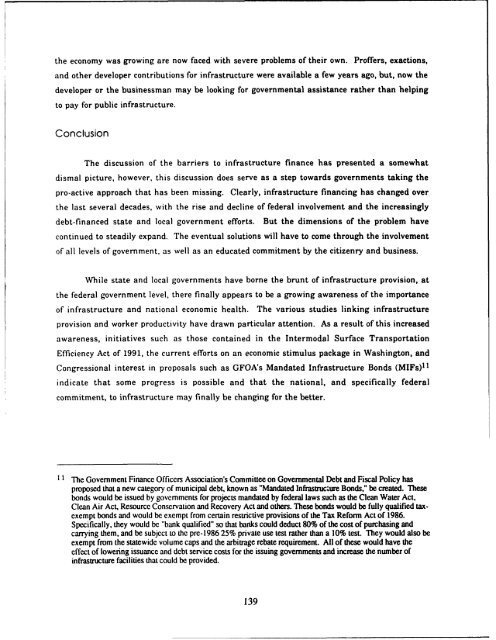Challenges and Opportunities for Innovation in the Public Works ...
Challenges and Opportunities for Innovation in the Public Works ...
Challenges and Opportunities for Innovation in the Public Works ...
Create successful ePaper yourself
Turn your PDF publications into a flip-book with our unique Google optimized e-Paper software.
<strong>the</strong> economy was grow<strong>in</strong>g are now faced with severe problems of <strong>the</strong>ir own. Proffers, exactions,<br />
<strong>and</strong> o<strong>the</strong>r developer contributions <strong>for</strong> <strong>in</strong>frastructure were available a few years ago, but, now <strong>the</strong><br />
developer or <strong>the</strong> bus<strong>in</strong>essman may be look<strong>in</strong>g <strong>for</strong> governmental assistance ra<strong>the</strong>r than help<strong>in</strong>g<br />
to pay <strong>for</strong> public <strong>in</strong>frastructure.<br />
Conclusion<br />
The discussion of <strong>the</strong> barriers to <strong>in</strong>frastructure f<strong>in</strong>ance has presented a somewhat<br />
dismal picture, however, this discussion does serve as a step towards governments tak<strong>in</strong>g <strong>the</strong><br />
pro-active approach that has been miss<strong>in</strong>g. Clearly, <strong>in</strong>frastructure f<strong>in</strong>anc<strong>in</strong>g has changed over<br />
<strong>the</strong> last several decades, with <strong>the</strong> rise <strong>and</strong> decl<strong>in</strong>e of federal <strong>in</strong>volvement <strong>and</strong> <strong>the</strong> <strong>in</strong>creas<strong>in</strong>gly<br />
debt-f<strong>in</strong>anced state <strong>and</strong> local government ef<strong>for</strong>ts. But <strong>the</strong> dimensions of <strong>the</strong> problem have<br />
cont<strong>in</strong>ued to steadily exp<strong>and</strong>. The eventual solutions will have to come through <strong>the</strong> <strong>in</strong>volvement<br />
of all levels of government, as well as an educated commitment by <strong>the</strong> citizenry <strong>and</strong> bus<strong>in</strong>ess.<br />
While state <strong>and</strong> local governments have borne <strong>the</strong> brunt of <strong>in</strong>frastructure provision, at<br />
<strong>the</strong> federal government level, <strong>the</strong>re f<strong>in</strong>ally appears to be a grow<strong>in</strong>g awareness of <strong>the</strong> importance<br />
of <strong>in</strong>frastructure <strong>and</strong> national economic health. The various studies l<strong>in</strong>k<strong>in</strong>g <strong>in</strong>frastructure<br />
provision <strong>and</strong> worker productivity have drawn particular attention. As a result of this <strong>in</strong>creased<br />
awareness, <strong>in</strong>itiatives such as those conta<strong>in</strong>ed <strong>in</strong> <strong>the</strong> Intermodal Surface Transportation<br />
Efficiency Act of 1991, <strong>the</strong> current ef<strong>for</strong>ts on an economic stimulus package <strong>in</strong> Wash<strong>in</strong>gton, <strong>and</strong><br />
Congressional <strong>in</strong>terest <strong>in</strong> proposals such as GFOA's M<strong>and</strong>ated Infrastructure Bonds (MIFs) 1 I<br />
<strong>in</strong>dicate that some progress is possible <strong>and</strong> that <strong>the</strong> national, <strong>and</strong> specifically federal<br />
commitment, to <strong>in</strong>frastructure may f<strong>in</strong>ally be chang<strong>in</strong>g <strong>for</strong> <strong>the</strong> better.<br />
1 The Government F<strong>in</strong>ance Officcrs Association's Committee on Governmental Debt <strong>and</strong> Fiscal Policy has<br />
proposed that a new category of municipal debt, known as "M<strong>and</strong>ated Infrastrucaure Bonds," be created. These<br />
bonds would be issued by governments <strong>for</strong> projects m<strong>and</strong>ated by federal laws such as <strong>the</strong> Clean Water Act,<br />
Clean Air Act, Resource Conservation <strong>and</strong> Recovery Act <strong>and</strong> o<strong>the</strong>rs. These bonds would be fully qualified taxexempt<br />
bonds <strong>and</strong> would be exempt from certa<strong>in</strong> restrictive provisions of <strong>the</strong> Tax Re<strong>for</strong>m Act of 1986.<br />
Specifically, <strong>the</strong>y would be "bank qualified" so that banks could deduct 80% of <strong>the</strong> cost of purchas<strong>in</strong>g <strong>and</strong><br />
carry<strong>in</strong>g <strong>the</strong>m, <strong>and</strong> be subject to <strong>the</strong> pre-1986 25% private use test ra<strong>the</strong>r than a 10% test. They would also be<br />
exempt from <strong>the</strong> statewide volume caps <strong>and</strong> <strong>the</strong> arbitrage rebate requirement. All of <strong>the</strong>se would have <strong>the</strong><br />
effect of lower<strong>in</strong>g issuance <strong>and</strong> debt service costs <strong>for</strong> <strong>the</strong> issu<strong>in</strong>g governments <strong>and</strong> <strong>in</strong>crease <strong>the</strong> number of<br />
<strong>in</strong>frastructure facilities that could be provided.<br />
139







